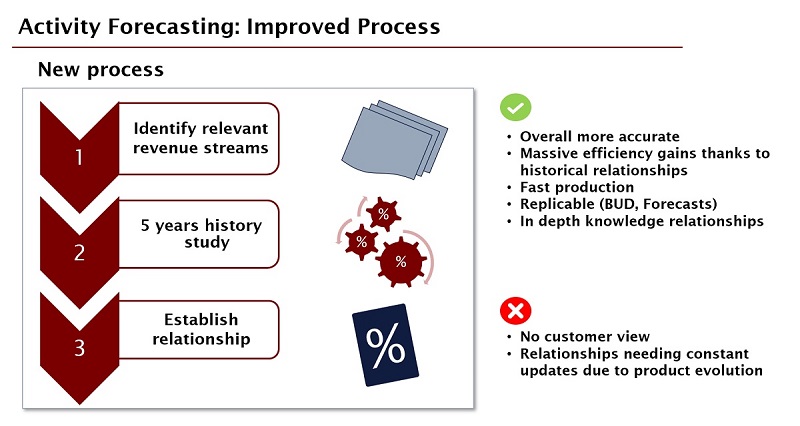In this video, Charles Peter, Finance Director Global sales, marketing and operations at Microsoft, shares his experience...

Why Do We Struggle with Forecasting Consistency?
Recent events and geopolitical situations demonstrate how difficult it is to produce reliable forecasts. It is often a daunting task which involves a large amount of data, technical skills, tools and a bit of luck. Plenty of literature offer guidelines on the subject. Another less known but not less significant challenge is forecasting consistency across different units within the same organisation. For example, it does not necessarily mean that Operations are producing a cost forecast consistent with the revenue profile just because the Sales department has produced a good revenue forecast. Consequently, it can be challenging when revenues and costs do not necessarily follow the same patterns for whatever reason.
How can we ensure forecasts produced by different business units are combined into one single consistent and comprehensive exercise? Even within the same organisation, different units can approach the same topic differently: consider inflation's impact or exchange rates. Therefore, it is pivotal to establish a framework for a consistent approach and strive to provide as accurate forecasts as possible. We can summarise this approach using the quote 'consistency over accuracy'. In reality, it is more important that one specific business area (for instance, headcount) is in line with the rest of the forecasting exercise (revenues and costs) rather than aiming to be as accurate as possible but in isolation.
Aligning Cost Projections with Revenue Forecasts
Let's dive into a specific case, highlighting the forecast inconsistency. A 'cost-only' Operational unit had to produce forecasts in line with a defined revenue profile. However, revenue forecasts have already been produced by the Sales departments, agreed upon, and loaded into corporate tools. For the 'cost-only' Operational unit, these represent an input. Therefore, the task becomes how to ensure the forecasted costs align with these revenue profiles. Indeed, it is not as straightforward exercise as it might have appeared due to operational complexities around specific customer contracts, which may differ substantially. This is true, especially for large customers, who tend to require a more tailored customer experience.
Costs incurred by the specific Operational unit are mainly represented by labour and driven by the headcount organised in many technical departments. Fundamentally, the costs are related to six main processes. Employees are spread internationally and in different roles and levels, thus allowing an almost infinite number of different combinations and costs. Hence, understanding the evolution of the headcount over time according to the revenue profile evolution becomes crucial. Given the highly technical nature of the roles, the headcount number is strictly linked to the number of activities completed. These can be as follows:
- installations,
- network configurations,
- network modifications,
- additions, and so on.
The problem then becomes how to forecast such activities, after which the headcount more or less follows.
What Were the Previous Forecasting Method and Related Issues?

Figure 1. Source: Nick Arzenton's presentation at the FP&A Trends Webinar, May 2023
The Operations department received extensively detailed revenue files with granularity by 1000+ large or medium customers. A detailed manual analysis was conducted, breaking down the revenue by individual customer, services, and nature. The organisational unit drew a conclusion around the evolution of the activities for that specific account.
What was the bottleneck? This exercise was highly complicated by the data volumes, which had to be handled manually. Revenue streams, which produced activity variations, had to be identified. For example, discounts had to be excluded from forecasts. Also, different services required different levels of activities and changes in the product mix. In turn, it could provide material changes in activity levels.
After consolidating these detailed analyses, the Operations could understand the whole picture. The issues with this method were as follows:
- First and foremost, this truly bottom-up exercise didn't necessarily guarantee an accurate picture, as the overall accuracy was relatively unsatisfactory.
- Also, the method was not efficient. It was so manually intensive and required a vast amount of resources, more or less dedicated to the exercise for a long time.
- Another key challenge was to agree with the Sales department on the required activities under the pressure of deadlines.
- There was no top-down view that could validate and confirm the results of the bottom-up exercise.
The New Forecasting Method

Figure 2. Source: Nick Arzenton's presentation at the FP&A Trends Webinar, May 2023
Identifying the historical relationship between revenues and activities over time was key for the new forecasting method. The Operations collected the same detailed revenue files and activity levels for the last five years to try a new approach. The team analysed the trends over these periods for each of the six main processes without necessarily going into the details regarding the customer.
The second step in the new forecasting method was to identify patterns. Indeed, these emerged, and valuable discussions took place in order to understand trends and the underlying business reasons accounting for these trends. Also, the organisation produced documentation to formally agree on conclusions between the Sales and Operations departments. This aspect was another key consideration since work on the historical data could take place before the need for any budgets or forecasts.
The historical analysis came in handy when the next forecast was needed. The newly identified relationships could be quickly deployed to establish the activity evolution, from which to derive the headcount needs. The relationships are more 'high level' than before, while customer information is analysed only in very specific cases, not as a matter of process. If new elements, such as a new product, come into play and disrupt the model, they can be quickly absorbed into the method with some minor tweaks.
Benefits and Recommendations
Such a model offers numerous substantial advantages. Thanks to historical relationships, time-consuming analyses are no longer necessary. Other benefits are the increased forecasting speed and the impact on efficiency and costs. Another important aspect is that the model was developed together by Sales and Operations, thus negating the need for lengthy discussions to agree upon forecasts. Finally, the studies yielded another bonus – an increase in business knowledge.
Recommendations for the practical application of this forecasting method include the following:
-
Availability of good historical data
We are all familiar with the data quality issues. Also, we need to remember that if we perform a historical analysis like this one, additional challenges may arise as data capturing might have changed over time. It will always be necessary to perform manual adjustments and corrections.
-
Knowledge and collective operational experience
We need both to understand trends and evolutions, as well as to establish meaningful relationships.
-
Management buy-in
It is pivotal to obtain top management support. While this forecasting method, supported by solid historical analysis, might appear as a 'leap in the unknown', some departments may be uncomfortable with its implementation because large amounts of details are no longer analysed nor considered.
Conclusion
The method has been initially developed in Excel. A new tool is being considered. AI has been utilised, but for the time being, only at an embryonic level, mainly to provide some specific outputs related to seasonality forecasting. The new method was no silver bullet on the topic of forecasting. However, it was a great practical help to ease an extremely complex exercise, allowing the organisation to focus on its core mission.
---
To watch the webinar recording where Nick shared his insights, please follow this link.
Subscribe to
FP&A Trends Digest

We will regularly update you on the latest trends and developments in FP&A. Take the opportunity to have articles written by finance thought leaders delivered directly to your inbox; watch compelling webinars; connect with like-minded professionals; and become a part of our global community.




